Exploring Challenges and Opportunities of Biophilic Urban Design: Evidence from Research and Experimentation
Abstract
1. Introduction
2. Methods
3. Theoretical Frameworks on Health and Nature
3.1. Adaptive and Utility Paradigms
3.2. Understanding Nature-Health Research through the Adaptive and Utility Paradigms
3.3. Research to Practice: Design Theory, Research, and Application
3.4. Experimental Biophilic Design Approaches
4. Mainstreaming Biophilic Design: Research, Design, and Practice
4.1. Building-Scale Applications: Living Lab at the Shard, London
4.2. Scale Jumping: District- and City-Level Applications of Integrated Design and Research
4.3. Urban Park-Scale Applications: Queen Elizabeth Olympic Park
4.4. District-Scale Applications: Greenwich Millennium Village
4.5. Neighborhood-Scale Applications: The Barbican
4.6. Community-Scale Applications: Mudchute Park and Farm at the Isle of Dogs
4.7. Exploring Multi-Sensory Experiences through Experimental Biophilic Design: Olafur Eliasson at Tate Modern
4.8. Linking Resilience with Social Justice and Economic Revitalization: Learning from Chicago
5. Discussion
5.1. Understanding the Application of Research to Practice
5.1.1. Benefits of Nature in the Workplace
5.1.2. Biophilic Design and Mental Health
5.1.3. Biophilic Design and Connectedness to Nature: A Tool for Environmental Behavior Change
5.1.4. Connecting Biophilic Design with Environmental Justice, Health, and Climate Change
5.1.5. Looking Forward: Engaging with Nature and Fostering a Systems-Thinking Approach
6. Conclusions
Author Contributions
Funding
Institutional Review Board Statement
Informed Consent Statement
Data Availability Statement
Acknowledgments
Conflicts of Interest
Declaration
Abbreviations
| ART | Attention Restoration Theory |
| PSR | Psychophysiological Stress Reduction |
| COST | Cooperation in Science and Technology |
| RESTORE | Rethinking Sustainability Toward a Regenerative Economy |
References
- Hadavi, S.; Kaplan, R.; Hunter, M.C.R. Environmental affordances: A practical approach for design of nearby outdoor settings in urban residential areas. Landsc. Urban Plan. 2015, 134, 19–32. [Google Scholar] [CrossRef]
- Kaplan, S. The restorative benefits of nature: Toward an integrative framework. J. Environ. Psychol. 1995, 15, 169–182. [Google Scholar] [CrossRef]
- Thompson, C.W.; Roe, J.; Aspinall, P.; Mitchell, R.; Clow, A.; Miller, D. More green space is linked to less stress in deprived communities: Evidence from salivary cortisol patterns. Landsc. Urban Plan. 2012, 105, 221–229. [Google Scholar] [CrossRef]
- Acuto, M. COVID-19: Lessons for an Urban(izing) World. One Earth 2020, 2, 317–319. [Google Scholar] [CrossRef]
- Wu, X.; Nethery, R.C.; Sabath, B.M.; Braun, D.; Dominici, F. Exposure to air pollution and COVID-19 mortality in the United States. Available online: https://projects.iq.harvard.edu/covid-pm?gsBNFDNDN=undefined&utm_campaign=wp_the_energy_202&utm_medium=email&utm_source=newsletter&wpisrc=nl_energy202 (accessed on 12 May 2020).
- Beute, F.; Andreucci, M.B.; Lammel, A.; Davies, Z.; Glanville, J.; Keune, H.; Marselle, M.; O’Brien, L.A.; Olszewska-Guizzo, A.; Remmen, R.; et al. Types and Characteristics of Urban and Peri-Urban Green Spaces Having an Impact on Human Mental Health and Wellbeing. Report Prepared by an EKLIPSE Expert Working Group; Centre for Ecology & Hydrology: Wallingford, UK, 2020. [Google Scholar]
- Beute, F.; Davies, Z.; de Vries, S.; Glanville, J.; Keune, H.; Lammel, A.; Marselle, M.; O’Brien, L.; Olszewska-Guizzo, A.; Remmen, R.; et al. Types and Characteristics of Urban and Peri-Urban Blue Spaces Having an Impact on Human Mental Health and Wellbeing. Report Prepared by an EKLIPSE Expert Working Group; Centre for Ecology & Hydrology: Wallingford, UK, 2020. [Google Scholar]
- Surico, J. The Power of Parks in a Pandemic. Available online: https://www.bloomberg.com/news/articles/2020-04-09/in-a-pandemic-the-parks-are-keeping-us-alive (accessed on 23 June 2020).
- Beatley, T. Handbook of Biophilic City Planning and Design; Island Press: Washington, DC, USA, 2016. [Google Scholar]
- Frumkin, H.; Bratman, G.N.; Breslow, S.J.; Cochran, B.; Kahn Jr, P.H.; Lawler, J.J.; Wolf, K.L. Nature contact and human health: A research agenda. Environ. Health Perspect. 2017, 125, 075001. [Google Scholar] [CrossRef] [PubMed]
- Loder, A. Small-Scale Urban Greening: Creating Places of Health, Creativity, and Ecological Sustainability; Routledge: Abingdon, UK, 2020. [Google Scholar]
- Yin, R.K. Application of Case Study Research; Sage: London, UK; New Delhi, India, 1993. [Google Scholar]
- Yin, R.K. Case Study Research: Design and Methods; Sage: London, UK; New Delhi, India, 1994. [Google Scholar]
- Keniger, L.E.; Gaston, K.J.; Irvine, K.N.; Fuller, R.A. What are the Benefits of Interacting with Nature? Int. J. Environ. Res. Public Heal. 2013, 10, 913–935. [Google Scholar] [CrossRef] [PubMed]
- Hartig, T.; Mitchell, R.; De Vries, S.; Frumkin, H. Nature and Health. Annu. Rev. Public Heal. 2014, 35, 207–228. [Google Scholar] [CrossRef]
- Dzhambov, A.M.; Markevych, I.; Hartig, T.; Tilov, B.; Arabadzhiev, Z.; Stoyanov, D.; Gatseva, P.; Dimitrova, D.D. Multiple pathways link urban green- and bluespace to mental health in young adults. Environ. Res. 2018, 166, 223–233. [Google Scholar] [CrossRef]
- Bratman, G.N.; Anderson, C.B.; Berman, M.G.; Cochran, B.; De Vries, S.; Flanders, J.; Folke, C.; Frumkin, H.; Gross, J.J.; Hartig, T.; et al. Nature and mental health: An ecosystem service perspective. Sci. Adv. 2019, 5, eaax0903. [Google Scholar] [CrossRef]
- Labib, S.; Lindley, S.; Huck, J.J. Spatial dimensions of the influence of urban green-blue spaces on human health: A systematic review. Environ. Res. 2020, 180, 108869. [Google Scholar] [CrossRef]
- Ballard, B. Biophilic office designs drive productivity and creativity. European CEO. Available online: https://www.europeanceo.com/business-and-management/biophilic-office-designs-drive-productivity-and-creativity/ (accessed on 16 June 2019).
- Millennium Ecosystem Assessment. Ecosystems and Human Well-being: Synthesis; Island Press: Washington, DC, USA, 2005. [Google Scholar]
- Gómez-Baggethun, E.; Barton, D.N. Classifying and valuing ecosystem services for urban planning. Ecol. Econ. 2013, 86, 235–245. [Google Scholar] [CrossRef]
- Wilson, E.O. Biophilia: The Human Bond with Other Species; Harvard University Press: Cambridge, MA, USA, 1984. [Google Scholar]
- Somarakis, G.; Stagakis, S.; Chrysoulakis, N. (Eds.) ThinkNature Nature-Based Solutions Handbook. ThinkNature project funded by the EU Horizon 2020 research and innovation programme under grant agreement No. 730338. 2019. Available online: https://platform.think-nature.eu/system/files/thinknature_handbook_final_print_0.pdf (accessed on 15 March 2021). [CrossRef]
- Kaplan, R.; Kaplan, S. Preference, Restoration, and Meaningful Action in the Context of Nearby Nature. In Urban Place: Reconnecting with the Natural World; Barlett, P., Ed.; MIT Press: Cambridge, UK, 2005; p. 330. [Google Scholar]
- Ulrich, R.S. Biophilia, Biophobia, and Natural Landscapes. In The Biophilia Hypothesis; Kellert, S.E.O.W., Ed.; Island Press: Washington, DC, USA, 1993; pp. 74–137. [Google Scholar]
- Kaplan, R.; Kaplan, S. The Experience of Nature: A Psychological Perspective; Cambridge University Press: Cambridge, UK, 1989. [Google Scholar]
- Hartig, T.; Mang, M.; Evans, G.W. Restorative Effects of Natural Environment Experiences. Environ. Behav. 1991, 23, 3–26. [Google Scholar] [CrossRef]
- Korpela, K.M.; Ylén, M.; Tyrväinen, L.; Silvennoinen, H. Determinants of restorative experiences in everyday favorite places. Heal. Place 2008, 14, 636–652. [Google Scholar] [CrossRef]
- Fromm, E. The Anatomy of Human Destructiveness; Holt, Rinehart and Winston: New York, NY, USA, 1973. [Google Scholar]
- Church, S.P. Exploring Green Streets and rain gardens as instances of small scale nature and environmental learning tools. Landsc. Urban Plan. 2015, 134, 229–240. [Google Scholar] [CrossRef]
- Davison, A. The trouble with nature: Ambivalence in the lives of urban Australian environmentalists. Geoforum 2008, 39, 1284–1295. [Google Scholar] [CrossRef]
- Liuna, G.; Jingke, X.; Lijuan, Y.; Wenjun, Z.; Kexin, Z. Connections with Nature and Environmental Behaviors. PLoS ONE 2015, 10. [Google Scholar] [CrossRef]
- Perrin, J.L.; Benassi, V.A. The connectedness to nature scale: A measure of emotional connection to nature? J. Environ. Psychol. 2009, 29, 434–440. [Google Scholar] [CrossRef]
- Wang, J.; Geng, L.; Schultz, P.W.; Zhou, K. Mindfulness Increases the Belief in Climate Change: The Mediating Role of Connectedness With Nature. Environ. Behav. 2019, 51, 3–23. [Google Scholar] [CrossRef]
- Wyles, K.J.; White, M.P.; Hattam, C.; Pahl, S.; King, H.; Austen, M. Are Some Natural Environments More Psycho-logically Beneficial Than Others? The Importance of Type and Quality on Connectedness to Nature and Psychological Restoration. Environ. Behav. 2019, 51, 111–143. [Google Scholar] [CrossRef]
- Braubach, M.; Egorov, A.; Mudu, P.; Wolf, T.; Thompson, C.W.; Martuzzi, M. Effects of Urban Green Space on Environmental Health, Equity and Resilience. In Nature-Based Solutions to Climate Change Adaptation in Urban Areas: Linkages between Science, Policy and Practice; Springer International Publishing: Cham, Switzerland; Berlin/Heidelberg, Germany, 2017; pp. 187–205. [Google Scholar]
- Kim, D.; Jin, J. Does happiness data say urban parks are worth it? Landsc. Urban Plan. 2018, 178, 1–11. [Google Scholar] [CrossRef]
- Han, B.; Cohen, D.A.; Derose, K.P.; Marsh, T.; Williamson, S.; Raaen, L. How much neighborhood parks contribute to local residents’ physical activity in the City of Los Angeles: A meta-analysis. Prev. Med. 2014, 69, S106–S110. [Google Scholar] [CrossRef]
- Kellert, S.R.; Wilson, E.O. The Biophilia Hypothesis; Island Press: Washington, DC, USA, 1993. [Google Scholar]
- Barton, J.; Griffin, M.; Pretty, J. Exercise, nature and socially interactive-based initiatives improve mood and self-esteem in the clinical population. Perspect. Public Heal. 2011, 132, 89–96. [Google Scholar] [CrossRef]
- Berg, M.M.V.D.; Van Poppel, M.; Van Kamp, I.; Ruijsbroek, A.; Triguero-Mas, M.; Gidlow, C.; Nieuwenhuijsen, M.J.; Gražulevičiene, R.; Van Mechelen, W.; Kruize, H.; et al. Do Physical Activity, Social Cohesion, and Loneliness Mediate the Association Between Time Spent Visiting Green Space and Mental Health? Environ. Behav. 2019, 51, 144–166. [Google Scholar] [CrossRef]
- Schipperijn, J.; Bentsen, P.; Troelsen, J.; Toftager, M.; Stigsdotter, U.K. Associations between physical activity and characteristics of urban green space. Urban For. Urban Green. 2013, 12, 109–116. [Google Scholar] [CrossRef]
- PennPraxis. Green2015: An Action Plan for the First 500 Acres. Philadelphia: City of Philadelphia. Available online: http://planphilly.com/green2015 (accessed on 30 August 2020).
- City of Philadelphia. Greenworks: A vision for a sustainable Philadelphia; Office of Sustainability: Philadelphia, PA, USA, 2016. [Google Scholar]
- Peters, K.; Elands, B.; Buijs, A. Social interactions in urban parks: Stimulating social cohesion? Urban For. Urban Green. 2010, 9, 93–100. [Google Scholar] [CrossRef]
- Holt-Lunstad, J.; Smith, T.B.; Layton, J.B. Social Relationships and Mortality Risk: A Meta-analytic Review. PLoS Med. 2010, 7, e1000316. [Google Scholar] [CrossRef]
- Sun, Z.; Zhu, D. Exposure to outdoor air pollution and its human health outcomes: A scoping review. PLoS ONE 2019, 14, e0216550. [Google Scholar] [CrossRef]
- Klompmaker, J.O.; Hoek, G.; Bloemsma, L.D.; Wijga, A.H.; van den Brink, C.; Brunekreef, B.; Janssen, N.A. As-sociations of combined exposures to surrounding green, air pollution and traffic noise on mental health. Environ. Int. 2019, 129, 525–537. [Google Scholar] [CrossRef]
- Calderón-Garcidueñas, L.; Torres-Jardón, R.; Kulesza, R.J.; Park, S.B.; D’Angiulli, A. Air pollution and detrimental effects on children’s brain. The need for a multidisciplinary approach to the issue complexity and challenges. Front. Hum. Neurosci. 2014, 8, 613. [Google Scholar]
- von Lindern, E.; Hartig, T.; Lercher, P. Traffic-related exposures, constrained restoration, and health in the residential context. Health Place 2016, 39, 92–100. [Google Scholar] [CrossRef]
- Tuan, Y.F. Rootedness versus sense of place. Landscape 1980, 24, 3–8. [Google Scholar]
- Williams, D.R. Making sense of ‘place’: Reflections on pluralism and positionality in place research. Landsc. Urban Plan. 2014, 131, 74–82. [Google Scholar] [CrossRef]
- Zufferey, C.; King, S. Social work learning spaces: The Social Work Studio. High. Educ. Res. Dev. 2016, 35, 395–408. [Google Scholar] [CrossRef]
- Cornell Health. Nature Rx. Cornell University. Available online: https://health.cornell.edu/resources/health-topics/nature-rx (accessed on 16 June 2019).
- Kallen, C. NaturePHL Bringing ‘Nature Prescriptions’ to Local Doctors’ Offices. Family Focus Media, Philadelphia. Available online: http://familyfocus.org/nature-phl-nature-prescriptions-philadelphia (accessed on 16 June 2019).
- Lachowycz, K.; Jones, A.P. Towards a better understanding of the relationship between greenspace and health: Development of a theoretical framework. Landsc. Urban Plan. 2013, 118, 62–69. [Google Scholar] [CrossRef]
- Trentelman, C.K. Place Attachment and Community Attachment: A Primer Grounded in the Lived Experience of a Community Sociologist. Soc. Nat. Resour. 2009, 22, 191–210. [Google Scholar] [CrossRef]
- Stedman, R.C.; Beckley, T.M. If we knew what it was we were doing, it would not be called research, would it? Soc. Nat. Resour. 2007, 20, 939–943. [Google Scholar] [CrossRef]
- Williams, D.R.; Patterson, M.E. Snapshots of What, Exactly? A Comment on Methodological Experimentation and Conceptual Foundations in Place Research. Soc. Nat. Resour. 2007, 20, 931–937. [Google Scholar] [CrossRef]
- Kellert, S.R. Dimensions, Elements, and Attributes of Biophilic Design. In Biophilic Design: The Theory, Science, and Practice of Bringing Buildings to Life; Kellert, S.R., Heerwagen, J., Mador, M., Eds.; John Wiley & Sons: Hoboken, NJ, USA, 2018. [Google Scholar]
- Browning, W.D.; Ryan, C.O.; Clancy, J.O. 14 Patterns of Biophilic Design; Terrapin Bright Green LLC: New York, NY, USA, 2014. [Google Scholar]
- McGee, B.; Park, N.; Portillo, M.; Bosch, S.; Swisher, M. Diy Biophilia: Development of the Biophilic Interior Design Matrix as a Design Tool. J. Inter. Des. 2019, 44, 201–221. [Google Scholar] [CrossRef]
- Pallasmaa, J.; Amundsen, M. Q&A with Juhani Pallasmaa on Architecture, Aesthetics of Atmospheres and the Passage of Time Questions-réponses avec Juhani Pallasmaa sur l’architecture, l’esthétique des ambiances et les effets du temps. Ambiances. Environnement sensible, architecture et espace urbain Comptes-rendus. Available online: http://journals.openedition.org/ambiances/1257 (accessed on 30 August 2019).
- Reeve, A.; Desha, C.; Hargroves, K.; Newman, P. Informing healthy building design with biophilic urbanism design principles: A review and synthesis of current knowledge and research. In Proceedings of the 10th International Conference on Healthy Buildings, Brisbane, Australia., 8–12 July 2012. [Google Scholar]
- Statista. Forecasted population in London (UK) from 2019 to 2041. Available online: https://www.statista.com/statistics/379035/london-population-forecast/ (accessed on 16 March 2021).
- Greenspace Information for Greater London CIC (GiGL). Key London Figures. Available online: https://www.gigl.org.uk/keyfigures/ (accessed on 16 March 2021).
- DaeWha Kang Design and Aldworth James & Bond. Using cutting-edge fabrication technology to construct unique working spaces in the UK’s tallest building. Kellert, S.R., and Calabrese, E.F. 2015. The practice of Biophilic design. Available online: www.biophilic-design.com (accessed on 10 February 2021).
- Kellert, S.R.; Calabrese, E.F. The practice of Biophilic design. Available online: www.biophilic-design.com (accessed on 10 February 2021).
- Dunnett, N. Naturalistic Planting Design: The Essential Guide; Filbert Press: London, UK, 2019. [Google Scholar]
- Smith, C.J.; Relph, E. Place and Placelessness. Geogr. Rev. 1978, 68, 116. [Google Scholar] [CrossRef]
- Loder, A. ‘There’s a meadow outside my workplace’: A phenomenological exploration of aesthetics and green roofs in Chicago and Toronto. Landsc. Urban Plan. 2014, 126, 94–106. [Google Scholar] [CrossRef]
- Klinenberg, E. Heat Wave: A Social Autopsy of Disaster in Chicago; University of Chicago Press: Chicago, IL, USA, 2002. [Google Scholar]
- City of Chicago, Department of Transportation. The Chicago Green Alley Handbook: An Action Guide to Create a Greener, Environmentally Sustainable Chicago. Available online: https://www.chicago.gov/dam/city/depts/cdot/GreenAlleyHandbook.pdf (accessed on 12 June 2019).
- Berkshire, M. Chicago Green Projects. In Small-Scale Urban Greening: Creating Places of Health, Creativity, And Ecological Sustainability; Loder, A., Ed.; Routledge: Abingdon, UK, 2020; p. 94. [Google Scholar]
- City of Chicago, Department of Water Management. Green Stormwater Infrastructure Strategy. Available online: https://www.chicago.gov/content/dam/city/progs/env/ChicagoGreenStormwaterInfrastructureStrategy.pdf (accessed on 10 July 2015).
- City of Chicago, Department of the Environment. New Stormwater Management Ordinance. Available online: https://www.chicago.gov/content/dam/city/depts/water/general/Engineering/MS4/MS4_Stormwater_Plan.pdf (accessed on 4 September 2018).
- Andreucci, M.B. Progettare L’involucro Urbano. Casi Studio di Progettazione Tecnologica Ambientale; Wolters Kluwer: Milano, Italy, 2019. [Google Scholar]
- 100 Resilient Cities. Available online: https://100resilientcities.org/ (accessed on 10 May 2019).
- Gobster, P.H.; Stewart, W.P.; van Riper, C.J.; Williams, A.R. Vacant Lot Stewardship and the Creation of New Natures in Chicago. In Proceedings of the International Association for Landscape Ecology Conference, Chicago, IL, USA, 8–12 April 2018. [Google Scholar]
- WLS-TV Chicago. City of Chicago selling more than 4K vacant lots for 1.ABC7EyewitnessNews. Available online: https://abc7chicago.com/news/city−of−chicago−selling−more−than−4k−vacant−lots−for−1.ABC7EyewitnessNews.November292019.https://abc7chicago.com/news/city−of−chicago−selling−more−than−4k−vacant−lots−for−1-/1630671/ (accessed on 29 November 2019).
- Lindsey, G.; Qi, Y.; Gobster, P.H.; Sachdeva, S. The 606 at Three: Trends in Use of Chicago’s Elevated Rail- Trail, Proceedings of the Fábos Conference on Landscape and Greenway Planning, 6, 37. Available online: https://scholarworks.umass.edu/fabos/vol6/iss1/37 (accessed on 10 June 2020).
- The Trust for Public Land. Our Story. The 606. Available online: https://www.the606.org/about/story/ (accessed on 26 May 2019).
- Smith, G.; Duda, S.; Lee, J.M.; Thompson, M. Measuring the Impact of the 606: Understanding How a Large Public In-vestment Impacted the Surrounding Housing Market. Chicago: Institute for Housing Studies at DePaul University. Available online: https://www.housingstudies.org/media/filer_public/2016/10/31/ihs_measuring_the_impact_of_the_606.pdf (accessed on 12 June 2019).
- Rodkin, D. Was gentrification around the 606 inevitable? Crain’s Chicago Business. Available online: https://www.chicagobusiness.com/residential-real-estate/was-gentrification-around-606-inevitable (accessed on 13 December 2019).
- Wessel, M. Chicago’s Resiliency Plan Aims for Equity. Next City. Available online: https://nextcity.org/daily/entry/chicagos-resiliency-plan-aims-for-equity (accessed on 24 April 2019).
- Green Stormwater Infrastructure Partners. Sustainable Business Network of Greater Philadelphia. The Economic Impact of Green City, Clean Waters: The First Five Years. 2016. Available online: https://gsipartners.sbnphiladelphia.org/wp-content/uploads/2014/07/Local-Economic-Impact-Report_First-Five-Years-GCCW_full-downloadable-web2.pdf (accessed on 12 June 2019).
- Berkshire, M. Resilient Corridors. In Rockefeller Foundation 100 Resilient Cities, Chicago: A plan for Inclusive Growth and a Connected City, City of Chicago. Available online: https://resilient.chicago.gov/download/Resilient%20Chicago.pdf (accessed on 5 June 2019).
- American Society of Landscape Architects. Chicago Resilient Corridors. Available online: https://il-asla.org/award/chicago-resilient-corridors/ (accessed on 2 October 2020).
- Macfarlane, R. London Becomes the World’s First National Park City. London National Park City. Available online: https://www.nationalparkcity.london/press/24-media/130-london-becomes-the-world-s-first-national-park-city (accessed on 14 June 2019).
- Choudhry, K.Z.; Coles, R.; Qureshi, S.; Ashford, R.; Khan, S.; Mir, R.R. A review of methodologies used in studies investigating human behaviour as determinant of outcome for exposure to ‘naturalistic and urban environments’. Urban For. Urban Green. 2015, 14, 527–537. [Google Scholar] [CrossRef]
- Li, D.; Deal, B.; Zhou, X.; Slavenas, M.; Sullivan, W.C. Moving beyond the neighborhood: Daily exposure to nature and adolescents’ mood. Landsc. Urban Plan. 2018, 173, 33–43. [Google Scholar] [CrossRef]
- Taylor, R.P. Reduction of Physiological Stress Using Fractal Art and Architecture. Leon 2006, 39, 245–251. [Google Scholar] [CrossRef]
- Richardson, M.; Dobson, J.; Abson, D.J.; Lumber, R.; Hunt, A.; Young, R.; Moorhouse, B. Applying the pathways to nature connectedness at a societal scale: A leverage points perspective. Ecosyst. People 2020, 16, 387–401. [Google Scholar] [CrossRef]
- Schultz, W.P.; Zelezny, L.C. Values as predictors of environmental attitudes: Evidence for consistency across cultures. J. Environ. Psychol. 1999, 19, 255–265. [Google Scholar] [CrossRef]
- Stern, P.C.; Dietz, T.; Kalof, L.; Guagnano, G.A. The new environmental paradigm in social psychological perspective. Environ. Behav. 1995, 27, 723–745. [Google Scholar] [CrossRef]
- Lumber, R.; Richardson, M.; Sheffield, D. Beyond knowing nature: Contact, emotion, compassion, meaning, and beauty are pathways to nature connection. PLoS ONE 2017, 12, e0177186. [Google Scholar] [CrossRef]
- Nash, R. Wilderness and the American Mind. Yale University Press: New Haven, CT, USA, 2001. [Google Scholar]
- Merchant, C. Reinventing Nature: Western Culture as a Recovery Narrative. In Uncommon Ground; Cronon, W., Ed.; W. W. Norton & Company: New York, NY, USA, 1995; pp. 132–159. [Google Scholar]
- Smith, N. The Production of Nature. In Future Natural: Nature, Science, Culture; Robertson, G.M.M., Tichner, L., Curtis, B., Putnam, T., Eds.; Routledge: London, UK, 1996; pp. 35–54. [Google Scholar]
- Baskin, J. Paradigm dressed as epoch: The ideology of the antropocene. Environ. Values 2015, 24, 9. [Google Scholar] [CrossRef]
- Catton, W.R.; Dunlap, R.E. Environmental Sociology: A New paradigm. Am. Sociol. 1978, 13, 41–49. [Google Scholar]
- IPBES. Summary for Policymakers of the Global Assessment Report on Biodiversity and Ecosystem Services of the Intergovernmental Science-Policy Platform on Biodiversity and Ecosystem Services; Díaz, S., Settele, J., Brondízio, E.S., Ngo, H.T., Guèze, M., Agard, J., Arneth, A., Balvanera, P., Brauman, K.A., Butchart, S.H.M., et al., Eds.; IPBES: Bonn, Germany, 2019. [Google Scholar]
- Ison, R.; Straw, E. The Hidden Power of Systems Thinking: Governance in a Climate Emergency; Routledge: London, UK, 2020. [Google Scholar]
- Loder, A. Regeneration. Between Ecological and Human Systems. In Progettare l’involucro Urbano: Casi Studio di Progettazione Tecnologica Ambientale; Andreucci, M.B., Ed.; Wolters Kluwer: Milano, Italy, 2019; p. 179. [Google Scholar]
- Africa, J.; Heerwagen, J.; Loftness, V.; Ryan Balagtas, C. Biophilic Design and Climate Change: Performance Parameters for Health. Front. Built Environ. 2019, 5, 28. [Google Scholar] [CrossRef]
- Settele, J.; Díaz, S.; Brondizio, D.; Daszak, P. COVID-19 Stimulus Measures Must Save Lives, Protect Livelihoods, and Safeguard Nature to Reduce the Risk of Future Pandemics. Intergovernmental Science-Policy Platform on Biodiversity and Ecosystem Services (IPBES Report). Available online: https://ipbes.net/covid19stimulus (accessed on 10 June 2020).
- Antonovsky, A. Unravelling the Mystery of Health; Jossey-Bass Inc: San Francisco, CA, USA, 1987. [Google Scholar]
- Brown, M. FutuREstorative: Working Towards a New Sustainability; RIBA Publishing: London, UK, 2016. [Google Scholar]
- Loder, A.; Gray, W.A.; Timm, S. The international WELL Building Institute’s Global Research Agenda. Available online: https://marketing.wellcertified.com/global-research-agenda (accessed on 10 February 2021).
- Roberts, A. How would nature Change Leadership? Available online: https://www.ted.com/talks/andres_roberts_how_would_nature_change_leadership (accessed on 7 May 2020).
- Mang, P.; Haggard, B. Regenerative Development and Design: A framework for Evolving Sustainability; Wiley: Hoboken, NJ, USA, 2016. [Google Scholar]
- World Commission on Environment and Development. Our Common Future; Oxford University Press: Oxford, UK, 1987. [Google Scholar]
- WHO Regional Office for Europe. Urban Green Space Interventions and Health: A Review of Impacts and Effectiveness. Copenhagen: WHO Regional Office for Europe. Available online: http://www.euro.who.int/__data/assets/ (accessed on 12 March 2018).
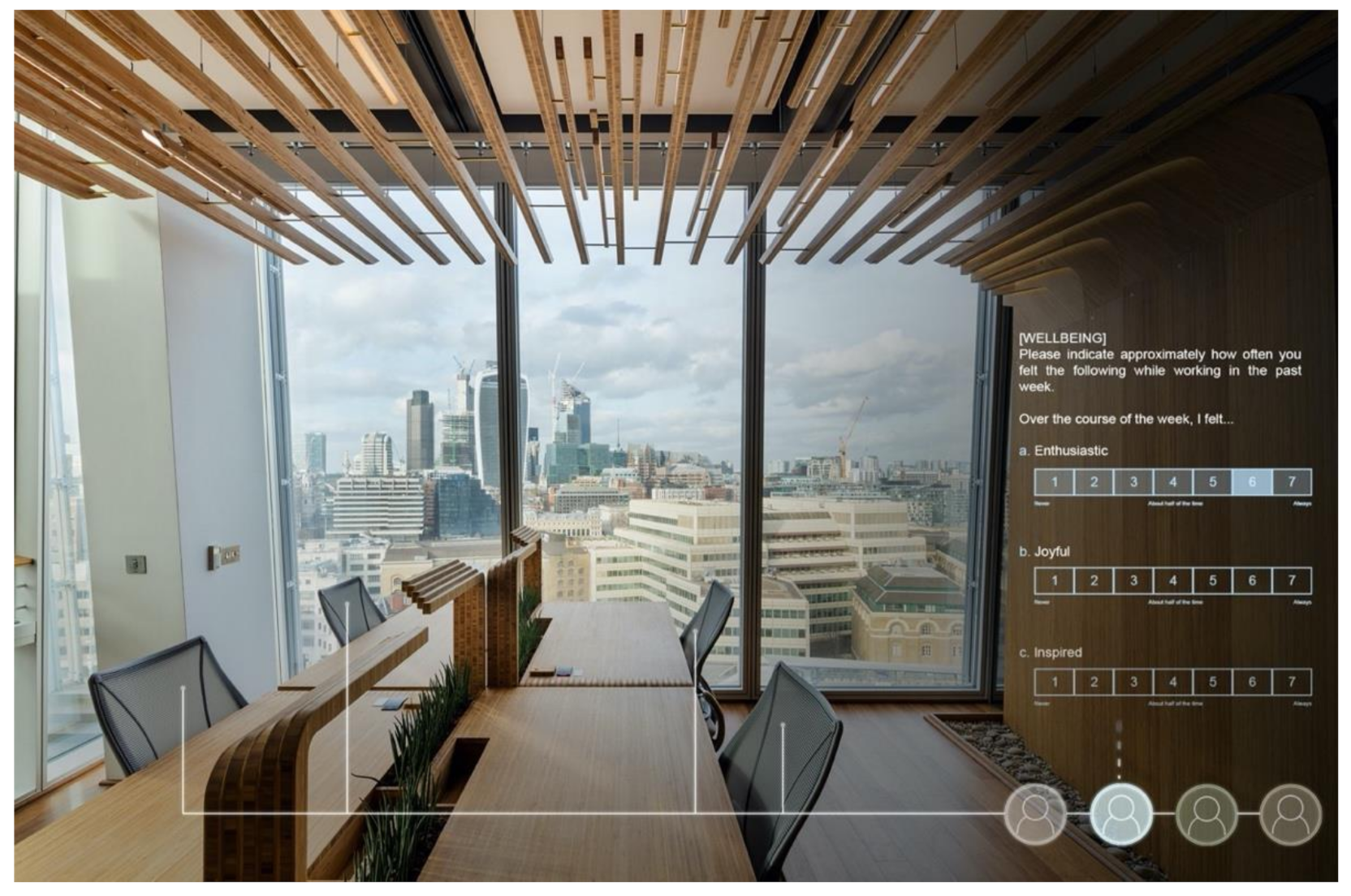
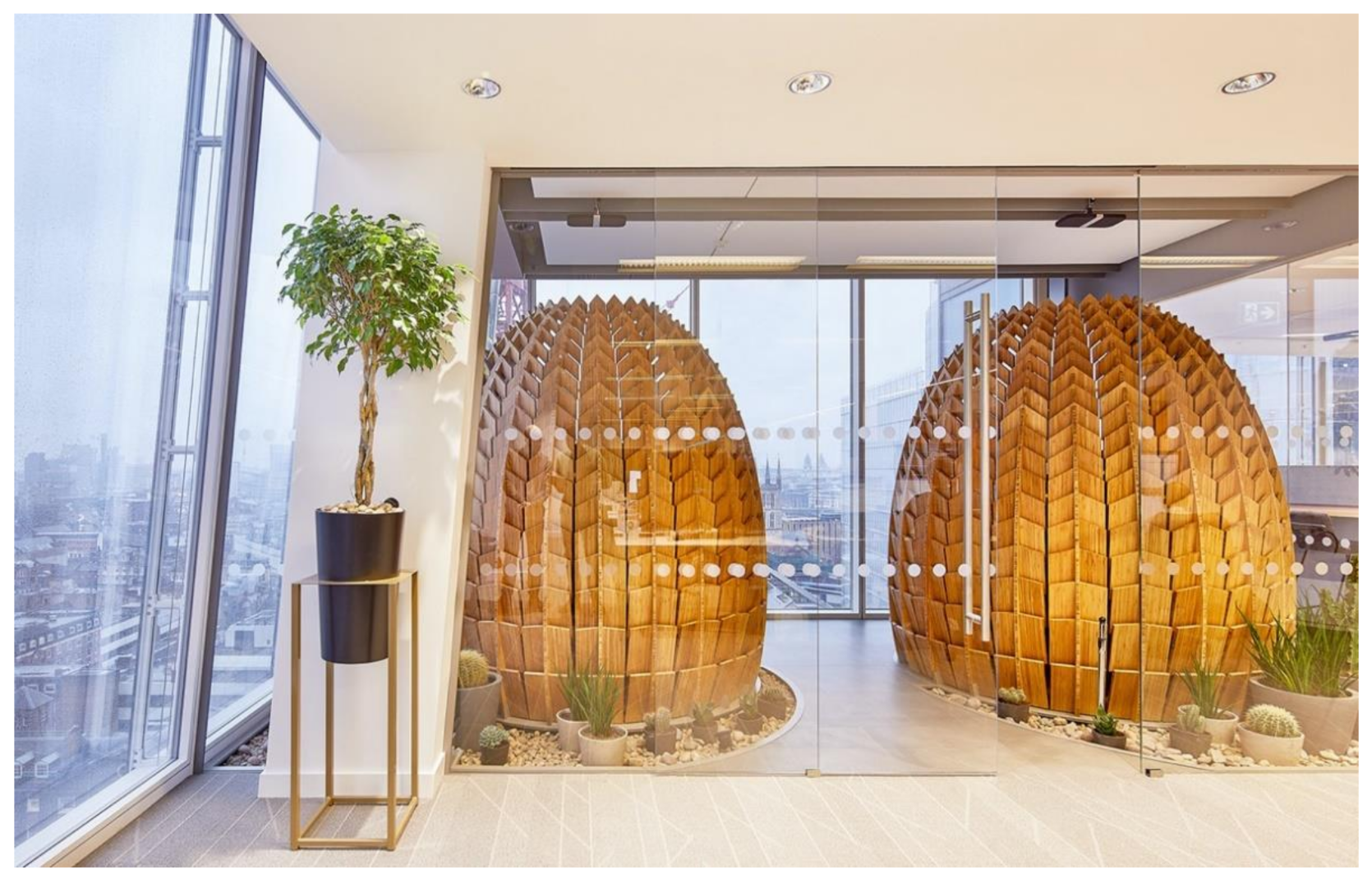
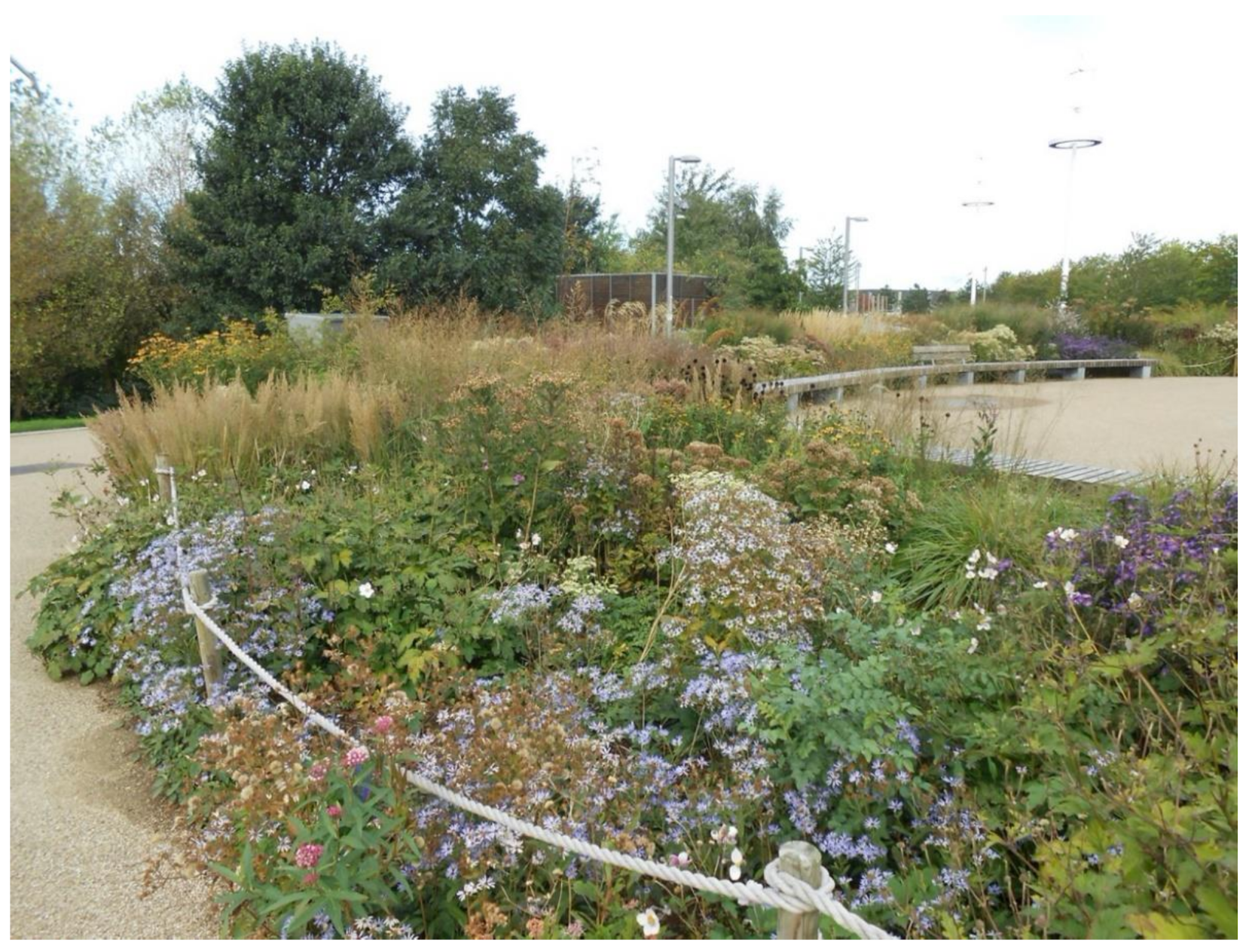
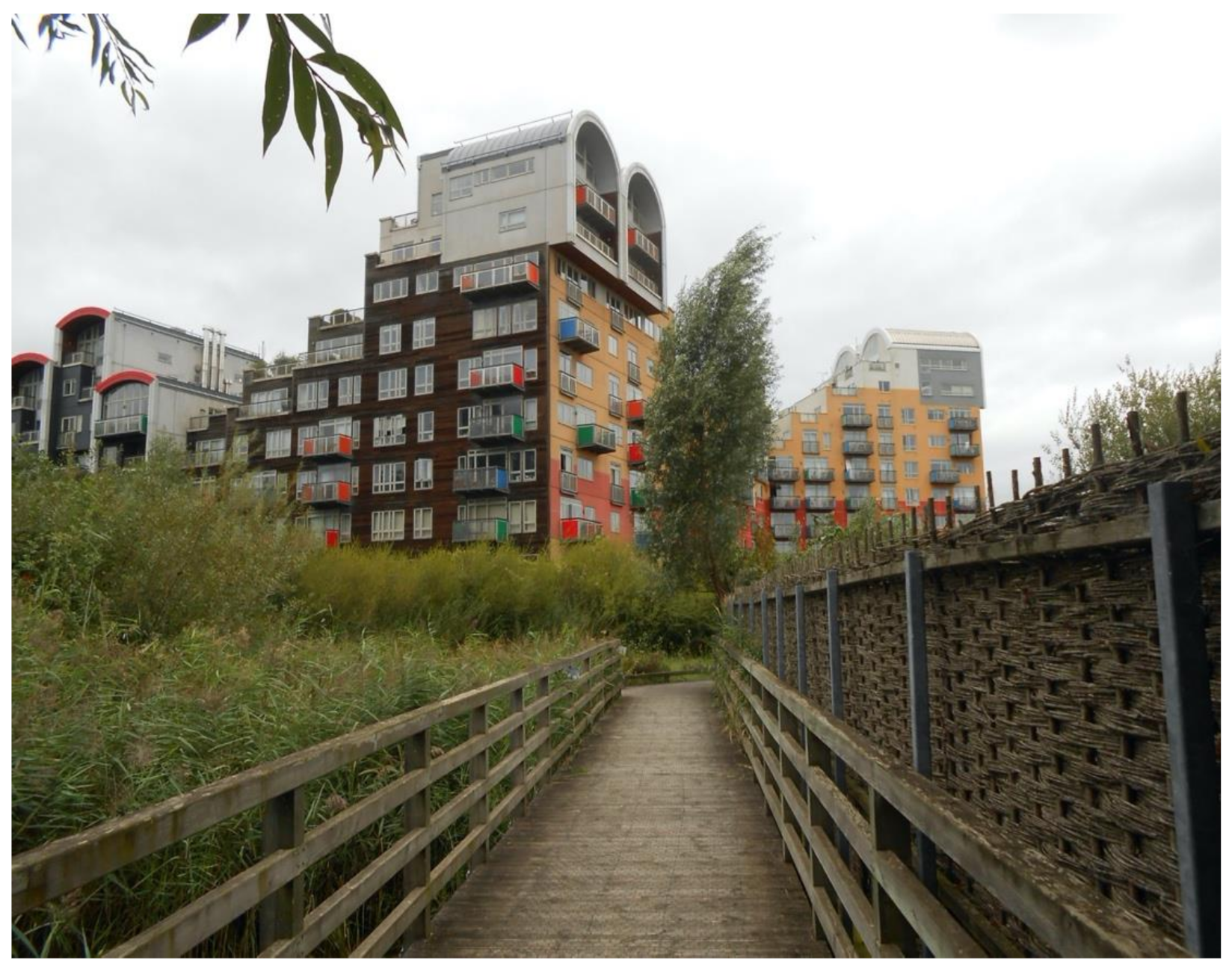

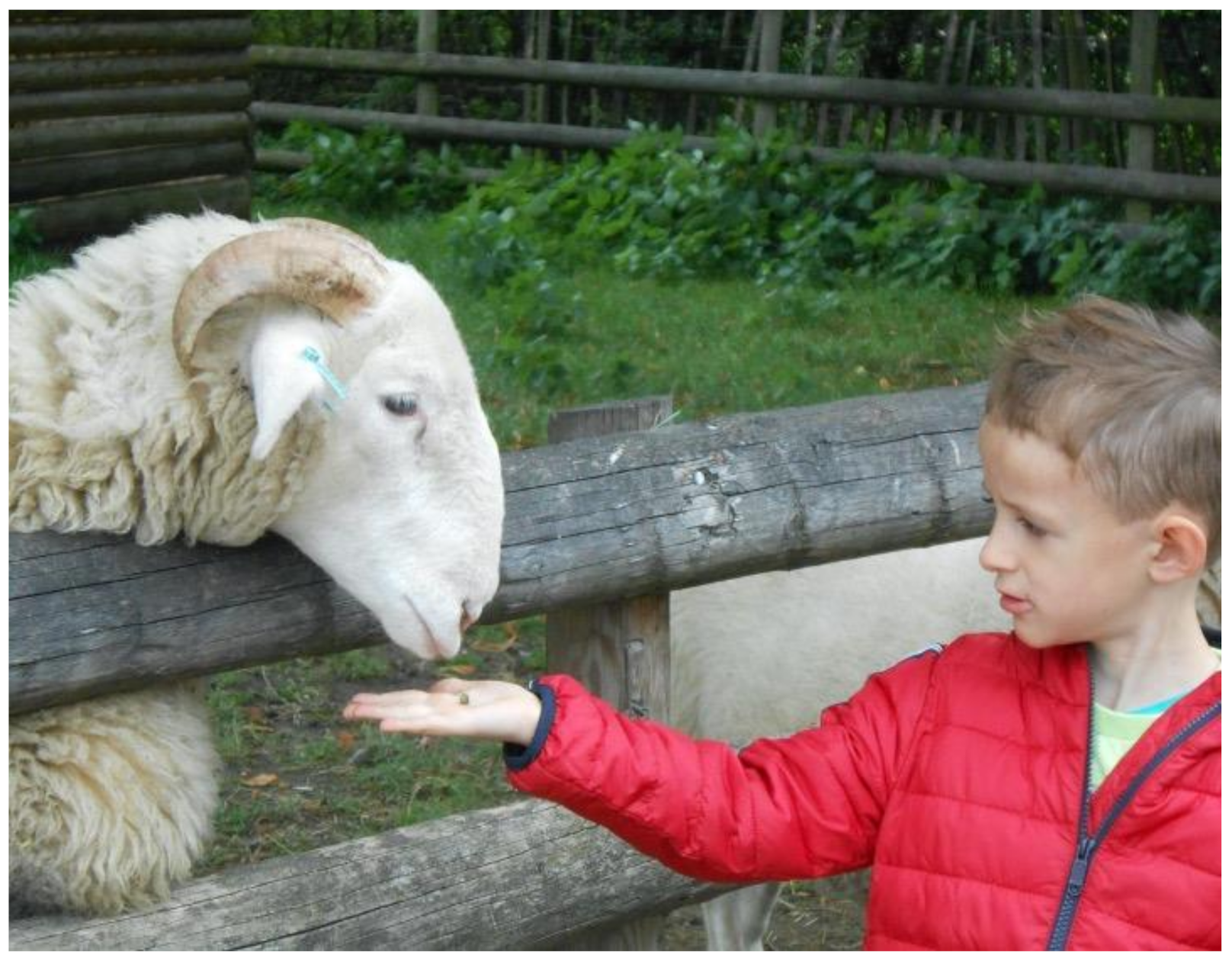
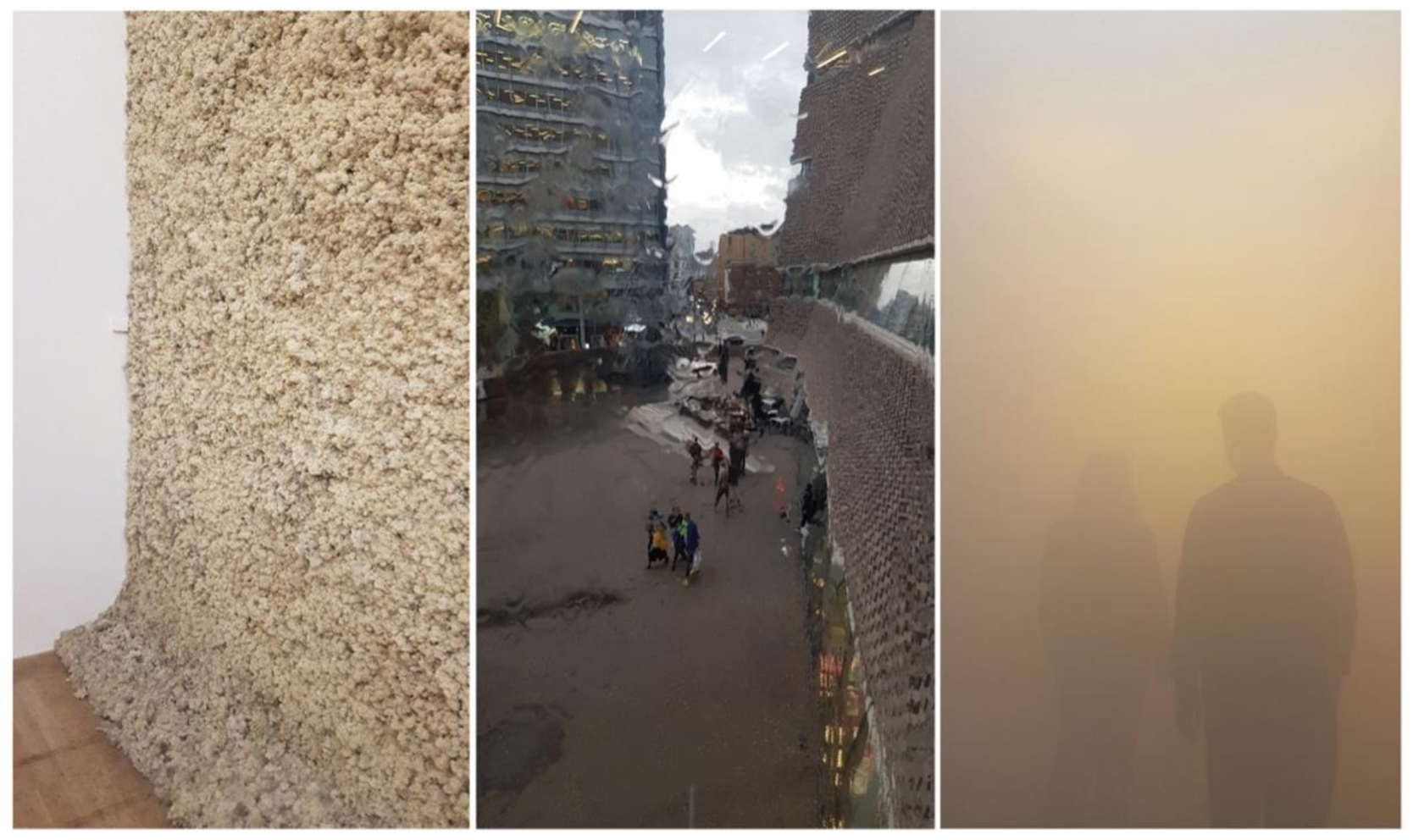
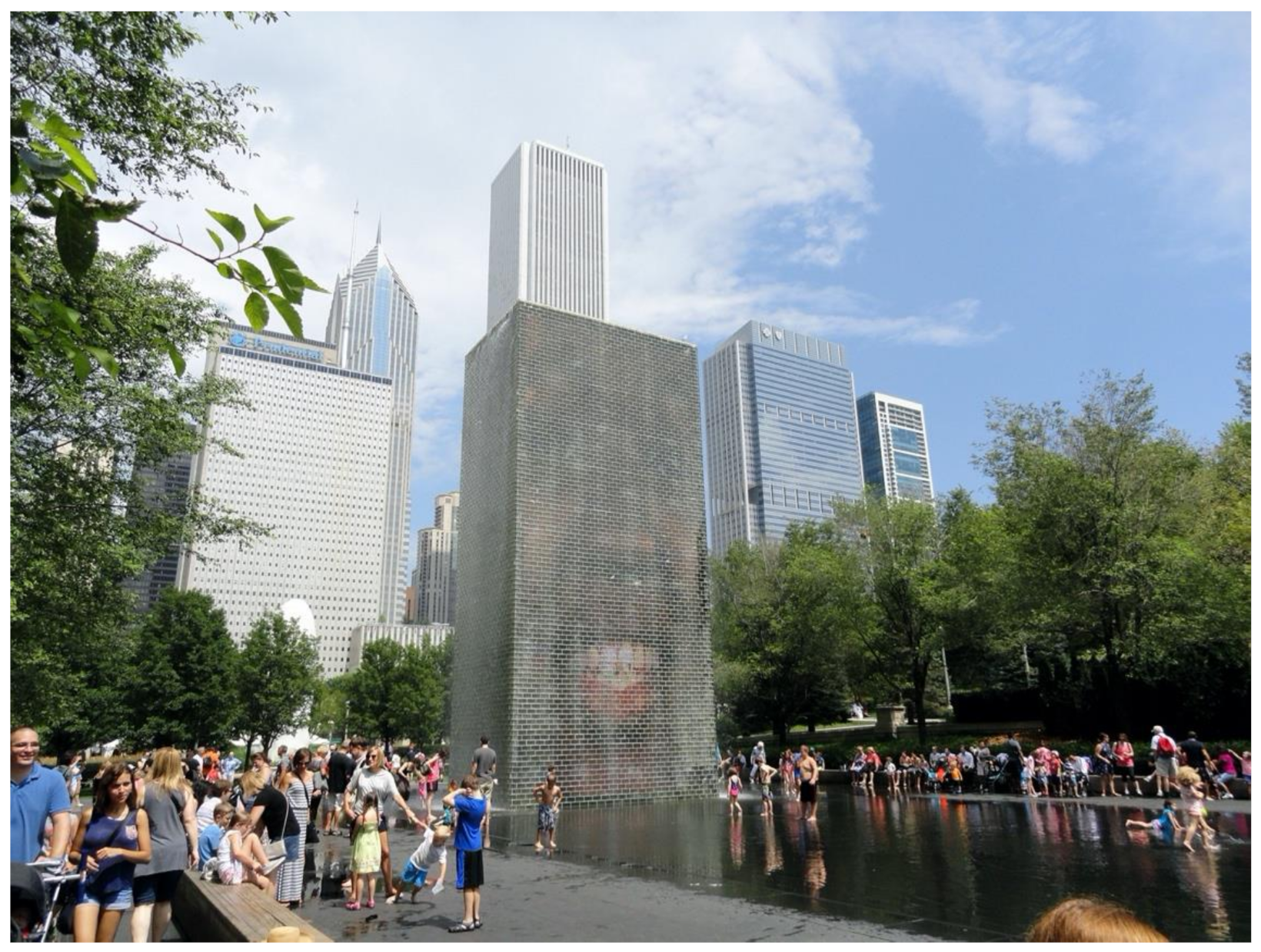
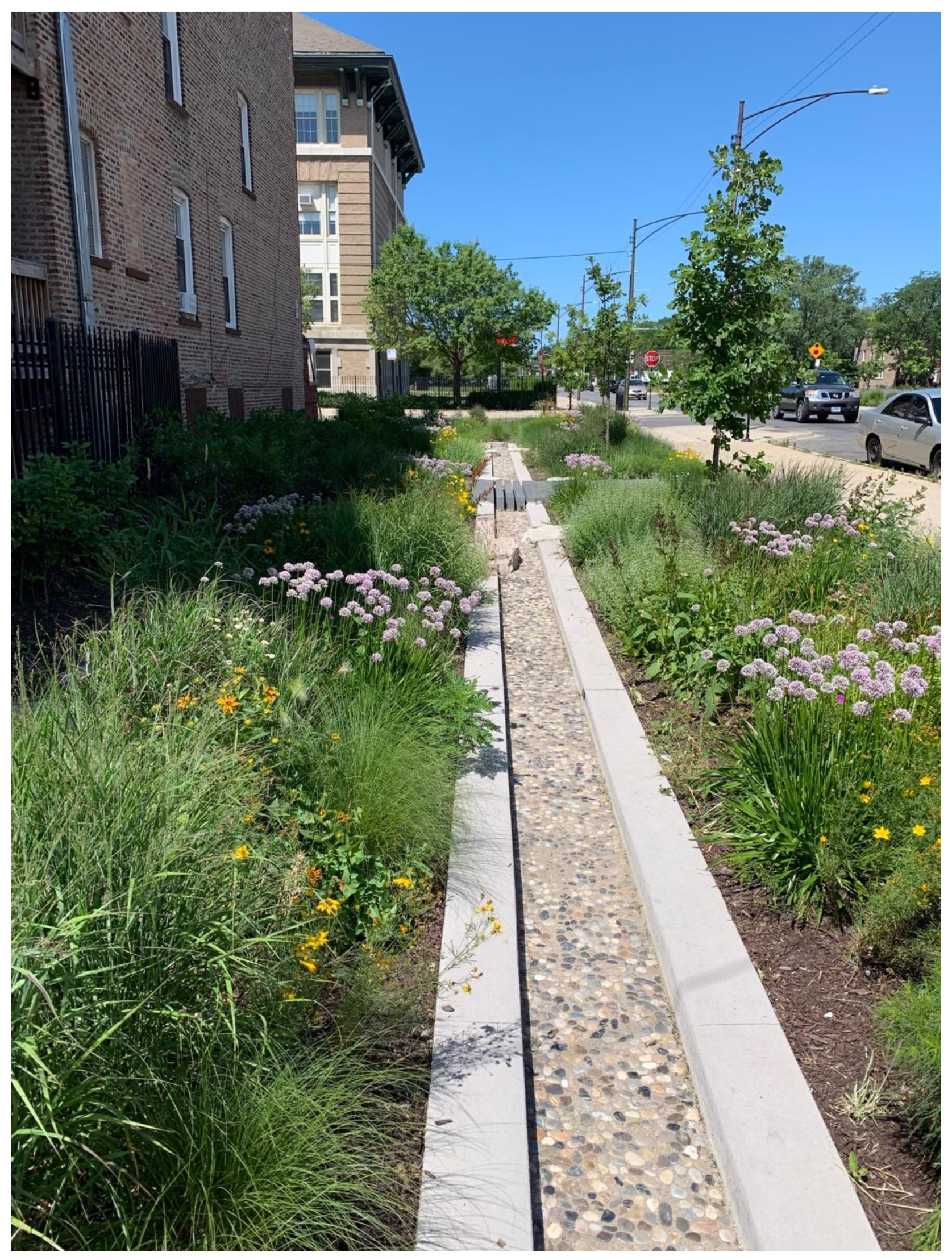
| Scale of Biophilic Design | Forms of Biophilic Elements | Taxonomy of Biophilic Elements |
|---|---|---|
| Building scale | Green roofs, green walls, shade trees, vegetation, and natural elements inside and around the building | Green roofs, green walls, shade trees, vegetation, and natural elements inside and around the building |
| District and neighborhood scales | Street trees, pocket parks, orchards and community gardens, business parks | Many installations, small-medium in size, restoration possible, high technical and technological requirements, public and private properties |
| City scale | City parks, urban forests, urban agriculture, waterfronts | Few installations, large in size, restoration possible, high technical and technological requirements, public land |
| Direct Experience of Nature | Indirect Experience of Nature | Experience of Space and Place |
|---|---|---|
| Light Water Vegetation Animals Weather Conditions Natural Landscape and Ecosystems Fire | Images of Nature Natural Materials Natural Colors Simulated Natural Light and Air Naturalistic Shapes and Forms Evoking Nature Information Richness Age, Change, and Patina of Time Natural Geometries Biomimicry | Prospect and Refuge Organized Complexity Integration of Parts to Wholes Transitional Spaces Mobility and Wayfinding Cultural and Ecological Attachment to place |
Publisher’s Note: MDPI stays neutral with regard to jurisdictional claims in published maps and institutional affiliations. |
© 2021 by the authors. Licensee MDPI, Basel, Switzerland. This article is an open access article distributed under the terms and conditions of the Creative Commons Attribution (CC BY) license (https://creativecommons.org/licenses/by/4.0/).
Share and Cite
Andreucci, M.B.; Loder, A.; Brown, M.; Brajković, J. Exploring Challenges and Opportunities of Biophilic Urban Design: Evidence from Research and Experimentation. Sustainability 2021, 13, 4323. https://doi.org/10.3390/su13084323
Andreucci MB, Loder A, Brown M, Brajković J. Exploring Challenges and Opportunities of Biophilic Urban Design: Evidence from Research and Experimentation. Sustainability. 2021; 13(8):4323. https://doi.org/10.3390/su13084323
Chicago/Turabian StyleAndreucci, Maria Beatrice, Angela Loder, Martin Brown, and Jelena Brajković. 2021. "Exploring Challenges and Opportunities of Biophilic Urban Design: Evidence from Research and Experimentation" Sustainability 13, no. 8: 4323. https://doi.org/10.3390/su13084323
APA StyleAndreucci, M. B., Loder, A., Brown, M., & Brajković, J. (2021). Exploring Challenges and Opportunities of Biophilic Urban Design: Evidence from Research and Experimentation. Sustainability, 13(8), 4323. https://doi.org/10.3390/su13084323







